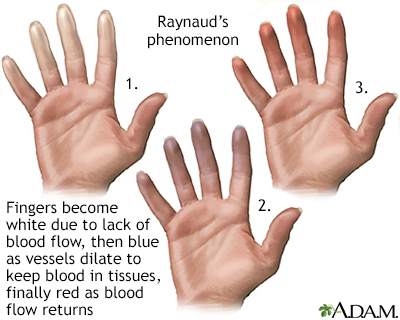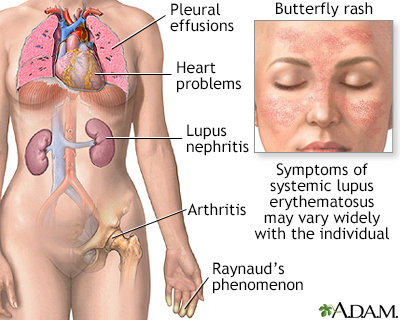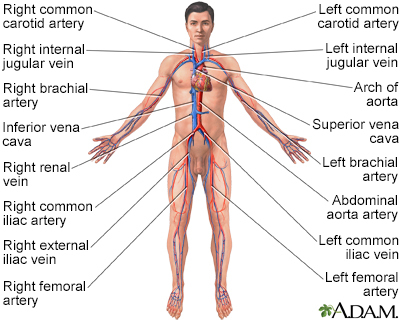Raynaud’s Phenomenon
If your fingers, toes, ears or nose become painful in freezing temperatures, you may be suffering from Raynaud’s [ray-NODES]...
Update your location to show providers, locations, and services closest to you.
Raynaud phenomenon is a condition in which cold temperatures or strong emotions cause blood vessel spasms. This blocks blood flow to the fingers, toes, ears, and nose.
Raynaud's phenomenon; Raynaud's disease
Raynaud phenomenon is called "primary" when it is not linked to another disorder. It most often begins in women younger than age 30. Secondary Raynaud phenomenon is linked to other conditions and usually occurs in people who are over age 30.
Common causes of secondary Raynaud phenomenon are:
Exposure to the cold or strong emotions bring on the changes.
People with primary Raynaud phenomenon have problems in the same fingers on both sides. Most people do not have much pain. The skin of the arms or legs develops bluish blotches. This goes away when the skin is warmed up.
People with secondary Raynaud phenomenon are more likely to have pain or tingling in the fingers. Painful ulcers may form on the affected fingers if the attacks are very bad.
Your health care provider can often discover the condition causing Raynaud phenomenon by asking you questions and doing a physical exam.
Tests that may be done to confirm the diagnosis include:
Taking these steps may help control Raynaud phenomenon:
Your provider may prescribe medicines to dilate the walls of the blood vessels. These include topical nitroglycerin cream that you rub on your skin, calcium channel blockers, sildenafil (Revatio), and tadalafil (Adcirca).
Low dose aspirin is often used to prevent blood clots.
For severe disease (such as when gangrene begins in fingers or toes), intravenous medicines may be used. Surgery may also be done to cut nerves that cause spasm in the blood vessels. People are most often hospitalized when the condition is this serious.
It is vital to treat the condition causing Raynaud phenomenon.
The outcome varies. It depends on the cause of the problem and how bad it is.
Complications may include:
Call your provider if:



Landry GJ. Raynaud phenomenon. In: Sidawy AN, Perler BA, eds. Rutherford's Vascular Surgery and Endovascular Therapy. 9th ed. Philadelphia, PA: Elsevier; 2019:chap 141.
Nassiri N, Dardik A. Raynaud's phenomenon. In: Cameron AM, Cameron JL, eds. Current Surgical Therapy. 13th ed. Philadelphia, PA: Elsevier; 2020:1035-1038.
Roustit M, Giai J, Gaget O, et al. On-demand Sildenafil as a treatment for Raynaud phenomenon: a series of n-of-1 trials. Ann Intern Med. 2018;169(10):694-703. PMID: 30383134 pubmed.ncbi.nlm.nih.gov/30383134/.
Stringer T, Femia AN. Raynaud's phenomenon: current concepts. Clin Dermatol. 2018;36(4):498-507. PMID: 30047433 pubmed.ncbi.nlm.nih.gov/30047433/.
If your fingers, toes, ears or nose become painful in freezing temperatures, you may be suffering from Raynaud’s [ray-NODES]...